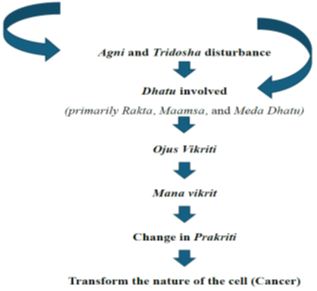Bridging Ancient Wisdom and Modern Oncology: Ayurvedic formulations for Arbuda in context of Cancer Management
DOI:
https://doi.org/10.21760/jaims.10.6.21Keywords:
Ayurveda, Arbuda, Cancer, Ayurvedic formulations, Sadapushpa, Vanatrapushi, UpodikaAbstract
Introduction: Ayurveda, the traditional Indian system of medicine, offers a holistic and nature-aligned perspective on health and disease. Arbuda is considered analogous to malignancies, including carcinoma and sarcoma. Cancer, now the leading global cause of death, is increasingly prevalent due to both intrinsic and extrinsic factors, including genetics, lifestyle, and environmental exposures. Ayurveda attributes the etiology of Arbuda and the influence of carcinogenic factors such as Ama, Visha, and Viruddha Ahara, which disrupt cellular homeostasis and immunity. While conventional treatments are effective, their non-selective cytotoxic effects can lead to considerable adverse outcomes. Ayurvedic therapies, particularly herbal formulations, may offer complementary benefits by mitigating treatment-induced side effects and promoting systemic recovery. This study seeks to catalog classical Ayurvedic formulations and single drugs referenced in the context of Arbuda, with the aim of exploring their integrative potential in preventive, palliative, or supportive cancer care.
Materials and Methods: This study involved a systematic review of classical Ayurvedic texts including Bruhatri and Laghutrayi, alongside 25 Nighantus and other Samhits. Electronic databases were searched using keywords "Arbuda".
Results: The review identified 35 formulations and three single drugs indicated for Arbuda. Single classical herbs such as Sadapushpaa, Vanatrapushi, and Upodika have shown potential anticancer activity in recent studies.
Discussion: Ayurvedic management of Arbuda employs a multifaceted approach targeting diverse pathogenic factors. This study emphasizes the potential role of classical formulations and single-drug therapies in integrative oncology and palliative care.
Downloads
References
Bray F, Laversanne M, Sung H, Ferlay J, Siegel RL, Soerjomataram I, et al. Global cancer statistics 2022: GLOBOCAN estimates of incidence and mortality worldwide for 36 cancers in 185 countries. CA Cancer J Clin. 2024;74(3):229–63.
Wu Z, Xia F, Lin R. Global burden of cancer and associated risk factors in 204 countries and territories, 1980–2021: a systematic analysis for the GBD 2021. J Hematol Oncol. 2024;17(1):119. https://doi.org/10.1186/s13045-024-01640-8
Ames BN, Gold LS, Willett WC. The causes and prevention of cancer. Proc Natl Acad Sci U S A. 1995;92(12):5258–65.
Rajkumar KC. Unveiling the truth in Ayurveda. 1st ed. Trivandrum: Vision Grafix; 2017. p.144–9.
Redd WH, Montgomery GH, DuHamel KN. Behavioral intervention for cancer treatment side effects. J Natl Cancer Inst. 2001;93(11):810–23. https://doi.org/10.1093/jnci/93.11.810
Trimble EL, Rajaraman P. Integrating traditional and allopathic medicine: an opportunity to improve global health in cancer. JNCI Monogr. 2017;(52):lgx011. https://doi.org/10.1093/jncimonographs/lgx011
Tripathi B. Charak Samhita. Vol. 2. Varanasi: Chaukhamba Surbhartii Prakashan; 2009.
Murthy Srikantha KR. Ashtanga Samgraha. 5th ed. Varanasi: Chaukhamba Surbhartii Prakashan; 2005.
Tripathi B. Sarngadhara Samhita. Varanasi: Chaukhamba Surbhartii Prakashan; 2010.
Nishteswar V. Sahasrayogam. Varanasi: Chaukhamba Sanskrit Series; 2023.
Das G. Bhaishajya Ratnavali. Varanasi: Chaukhamba Prakashan; 2010.
Sharma PV. Cakradatta. 1st ed. Varanasi: Chaukhamba Surbhartii Prakashan; 1994.
Sharma PV. Dravyaguna Vijnana. Vol. 1. Varanasi: Chaukhamba Surbhartii Prakashan; 2018.
Giri A, Narasu ML. Production of podophyllotoxin from Podophyllum hexandrum: a potential natural product for clinically useful anticancer drugs. Cytotechnology. 2000;34:17–26.
Aftab J, Mubeen T, Nasim A, Sajjad A, Qamrosh M, Zafar E, et al. Study of anticancer and antibacterial activities of Podophyllum hexandrum as natural curatives. Adv Complement Altern Med. 2020;5(2).
Ahmed F, Urooj A. In vitro hypoglycemic effects of different solvent extracts of Basella rubra L. fruits and leaves. Pharmacogn Mag. 2011;7(26):130–4.
Johnson IS, Wright HF, Svoboda GH, Vlantis J. Antitumor principles derived from Vinca rosea Linn I. Vincaleukoblastine and leurosine. Cancer Res. 1960;20(7):1016–22.
Sadaphal N, Gupta C. An updated review on Catharanthus roseus: its traditional and modern use for humankind. Der Pharma Chemica. 2022;14(8):48–54. https://doi.org/10.4172/0975-413X.14.8.48-54
Kowluru RA, Kowluru A. Oxidative stress and cancer. J Clin Biochem Nutr. 2018;63(2):99–108.
Turati F, Rossi M, Pelucchi C, et al. Dietary risk factors for cancer. Nutrients. 2020;12(12):3743.
American Cancer Society. Skin Cancer Facts & Statistics. 2022. Available from: https://www.cancer.org/cancer/skin-cancer.html
Mantovani A, Allavena P, Sica A, et al. Cancer-related inflammation. Cancer Res. 2019;79(11):2455–66.
International Agency for Research on Cancer. Diabetes. In: IARC Handbooks of Cancer Prevention. 2018. Available from: https://publications.iarc.fr/
Wu HC, Santella R. Genetic predisposition and environmental toxins in cancer. Nat Rev Cancer. 2020;20(10):547–61.
Singh N, Gupta S, Sharma R. Immunomodulatory effects of Abhayarishta in experimental models. J Ayurveda Integr Med. 2020;11(2):101–8.
Rajkapoor B, Jayakar B, Murugesh N. Anticancer activity of Bauhinia variegata Linn. against Dalton's ascitic lymphoma. J Pharm Pharmacol. 2003;55(8):1147–52.
Francis JA, Srinivasan BP, Abraham A. Anti-inflammatory and antioxidant effects of Gugulipid in rats. Biofactors. 2004;21(1–4):175–8.
Wanjari MM, Mishra S, Dey YN, Sharma D, Gaidhani SN, Jadhav AD. Antidiabetic activity of Chandraprabha vati. J Ayurveda Integr Med. 2016;7(3):144–50.
Palanivel V, Indu BH, Fakruddin SB, et al. Evaluation of pharmacological activity of Chandraprabha Vati on serum of albino Wistar strain rats. Int J Res Phytochem Pharmacol Sci. 2019;1(1):28–38.
Pushpa VH, Kuruburu MG, Jayanthi MK, et al. Bioactive profiling and evaluation of anti-proliferative and anti-cancerous properties of Shivagutika, an Indian polyherbal formulation. Front Chem. 2023;11:1195209.
Shi Y, Sahu RP, Srivastava SK. Triphala inhibits pancreatic tumor growth by inducing apoptosis. BMC Cancer. 2008;8:294.
Balachandran P, Govindarajan R. Cancer—an ayurvedic perspective. Pharmacol Res. 2005;51(1):19–30. https://doi.org/10.1016/j.phrs.2004.04.010
Manohar PR. Cancer research in Ayurveda: current status and future directions. J Ayurveda Integr Med. 2015;6(2):83–8. https://doi.org/10.4103/0975-9476.146548
Dhruva A, Wu HC, et al. Integrating ayurvedic medicine into cancer research programs part 2: ayurvedic herbs and research opportunities. Available from: https://www.ncbi.nlm.nih.gov/pmc/















